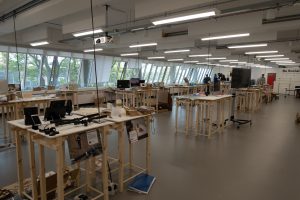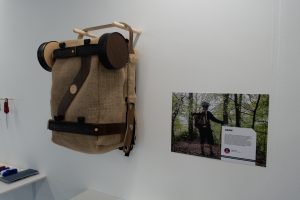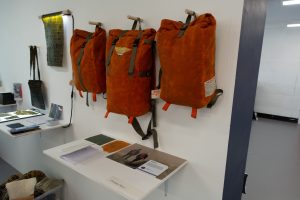DJCAD DEGREE SHOW 2019: PRODUCT DESIGN
Cooper Gallery, Level 5
18 – 26 May, DJCAD
On level five is the Product Design exhibition. Walking in, we find custom-made tables filling the room in small clusters, with each displaying a student’s work. The space feels open, simple and light, making it a comfortable place to be, especially following last year when the room felt dark and claustrophobic. I walk in alongside a film crew which gives the strong impression that the quality of work is high. Alongside each product are presentation boards, neatly hooked onto the table’s frame using two 3D printed brackets. Although simple, these show an attention to detail I’m not expecting. All boards have the same layout which gives the exhibition a cohesive and professional feel, alongside the identical tables.
displaying a student’s work. The space feels open, simple and light, making it a comfortable place to be, especially following last year when the room felt dark and claustrophobic. I walk in alongside a film crew which gives the strong impression that the quality of work is high. Alongside each product are presentation boards, neatly hooked onto the table’s frame using two 3D printed brackets. Although simple, these show an attention to detail I’m not expecting. All boards have the same layout which gives the exhibition a cohesive and professional feel, alongside the identical tables.
 One of the first projects we see is Calum Orr’s trail building backpack, LØAM. This stands out in the exhibition as an intriguing piece of design. Immediately the product raises questions: Are those wheels? Is it a rucksack? How does it work? The rucksack is designed to be carried while riding to the site then unfolds into a wheelbarrow for moving dirt. This seems like a niche but undeniably useful product for mountain bikers. However, questions about the durability of the product soon follow. The backpack is finished with the logo, a clean icon of a spade in soil, which completes a refined product.
One of the first projects we see is Calum Orr’s trail building backpack, LØAM. This stands out in the exhibition as an intriguing piece of design. Immediately the product raises questions: Are those wheels? Is it a rucksack? How does it work? The rucksack is designed to be carried while riding to the site then unfolds into a wheelbarrow for moving dirt. This seems like a niche but undeniably useful product for mountain bikers. However, questions about the durability of the product soon follow. The backpack is finished with the logo, a clean icon of a spade in soil, which completes a refined product.
One of the largest pieces in the exhibition is a wind turbine designed by Eli Weightman. Organism is an ornate sculpture designed to complement a lighthouse visitor centre and power a light inside. This turbine challenges the opinion that wind turbines are an eyesore, which the exhibition certainly isn’t. The six-foot-high turbine is a wonderful mixture of metals and wood. The central part is made of pieces of walnut built up into a cylinder. From this, brass rods with wooden petals extrude. I’m still unsure if the wind pushes the rods in, or as it turns they are pushed out; either way the movement gives the piece a kinetic feel. The turbine is designed for Scoraig, an off-grid community on the west coast of Scotland. As a piece of design it will certainly fit into the natural surroundings as well as the community. Whether it could be optimised to produce more power, or even if it will stand up to the constant abuse of a Scottish winter, remains to be seen.
At the back of the room we find Fraser Watt’s project, one of the most visually striking pieces in the exhibit. On the wall are three  rucksacks in a deep orange colour: the material has come from old Vango tents; the Vango logo still sewn to the largest one. The design is clean and simple, all three with roll tops. These rucksacks wouldn’t seem out of place next to the likes of Trakke or Millican, who have found success producing bags and packs in the UK. Fraser admits that there are a few rough edges, though with a bit more refining I could see these products on sale.
rucksacks in a deep orange colour: the material has come from old Vango tents; the Vango logo still sewn to the largest one. The design is clean and simple, all three with roll tops. These rucksacks wouldn’t seem out of place next to the likes of Trakke or Millican, who have found success producing bags and packs in the UK. Fraser admits that there are a few rough edges, though with a bit more refining I could see these products on sale.
Throughout the exhibit there are products designed to improve quality of life. From the seemingly simple but deeply refined, such as Molly McKinnon’s aircraft baby bassinet, to the technology driven projects like Nick Houston’s medication dispenser. The 100 word summary on the projects show a passion for the designer’s project, yet each product’s ability to help people suggests deeper underlying motivations. In this case, designing with the aim of helping the disadvantaged has produced some of the most well thought-out products in the show. It is clear 2019 has produced a number of great designers, inspiring projects and a range of refreshing products.
Hal Walsh

Leave a Reply